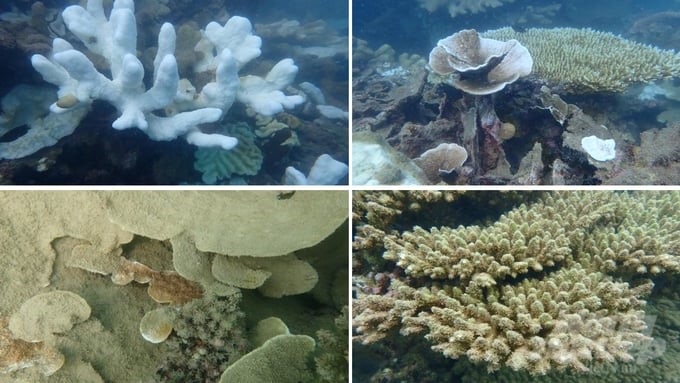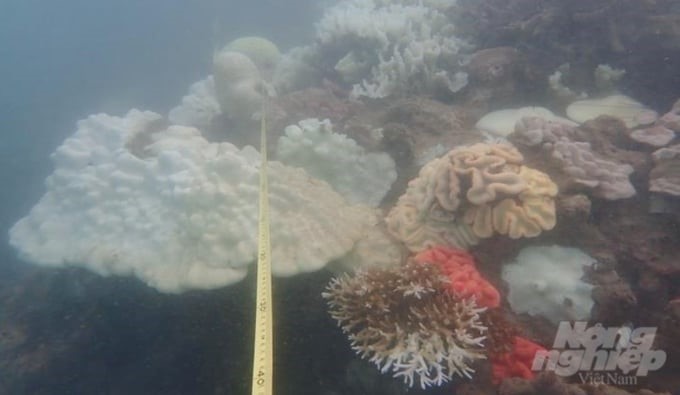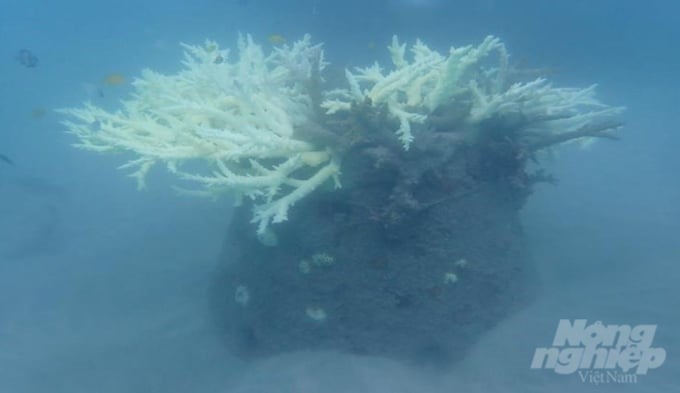December 3, 2025 | 01:00 GMT +7
December 3, 2025 | 01:00 GMT +7
Hotline: 0913.378.918
December 3, 2025 | 01:00 GMT +7
Hotline: 0913.378.918
Mr. Nguyen Khac Pho, Director of Con Dao National Park Management Board, said that the unit has completed the second field survey to evaluate and report to the Ba Ria-Vung Tau Provincial People's Committee on the situation of coral death and bleaching in the area. The survey was conducted with the participation of experts from the Institute of Oceanography under the Vietnam Academy of Science and Technology.

Coral in Con Dao continues to be bleached, dead, and covered with algae, settling in many sites. Photo: Nguyen Van Vung.
The survey area was in the second coral bleaching area with eight reef sites: four sites in the southeast and four sites in the northwest of the Con Dao archipelago. The survey also quickly evaluated three coral planting sites for restoration carried out in 2018–2019 in the Dat Doc area of Cat Lon Beach (Bay Canh Island) and the southern area of Hon Tai.
Through the survey, experts found that the seawater temperature at the sea surface and bottom at the time of this second survey remained at a threshold of 29–30 oC, a decrease of 2–3 oC compared to June 2024.
"After more than a month of bleaching, reef sites in the southeast of the island have a much higher rate of dead coral covered with algae than reef stations in the northwest. Coral died on both reef flats and reef slopes. In particular, coral at a depth of 2–4 m died more than coral at a depth of 5–14 m, and coral at the deep zone is still continuing to be bleached," Mr. Pho informed.
Coral in areas such as Dam Tre, Hon Cau, Hon Tai, Cua Ga, Cat Lon Beach, and Dat Doc died 80–90% in the shallow zone and continued to be bleached about 90% in the deep zone. In the areas of Ong Cuong and Ong Dung beaches, less coral died (about 50%) and showed signs of slow recovery.
Corals in the Northeast and Southeast died more than in the Northwest and Southwest. The main cause is that the seawater temperature has remained above 30 oC for a long time. Besides, the Con Dao area is starting the rainy season, leading to a lot of suspended matter and sediment deposited on the reef that cause coral to reduce its photosynthetic ability and recover slowly.

The assessment of coral bleaching due to the effects of climate change was carried out at eight sites in the Con Dao area. Photo: Nguyen Van Vung.
Through a series of actual data exploited from the bleaching warning system of Coral Reef Watch (CRW) until August 1, 2024, the Con Dao area has dropped to a level that is no longer affected by temperature pressure that causes bleaching. However, in August–September, coral in Con Dao still continued to be bleached at high and dangerous levels.
According to forecasts of the National Oceanic and Atmospheric Administration (NOAA), in the coming months, it can be identified that coral in the Con Dao area will continue to be bleached and die in the coming time, reducing the coral coverage on the reef and affecting reef quality, as well as changing the ecological functions of coral reefs in Con Dao.
The Con Dao National Park Management Board said the unit is continuing to implement programs to observe, supervise, and closely monitor the situation of coral bleaching on the bottom components, reef fish density, bottom animal density, and threats and impacts on coral reefs in the coming time.
Con Dao National Park's plan to plant and restore coral in 2024 must also be postponed because the coral on the reef has a very weak ability to recover after being bleached and dead. The parent coral breeding grounds that are expected to fragment the conglomerate are no longer able to provide seed sources for planting.

Coral planted and restored on concrete tank substrates in 2018–2019 was also bleached and died at Bay Canh Island. Photo: Nguyen Van Vung.
The Con Dao District People's Committee and Con Dao National Park recommend that the residential community, residents, and tourists minimize fishing and tourism activities at Ong Cuong Beach and Ong Dung Beach, aiming to join hands to protect potential reef areas as breeding grounds to serve future coral planting plans for restoration.
Translated by Thu Huyen

(VAN) Con Dao National Park officially received its Green List status after it was announced at the IUCN World Conservation Congress in Abu Dhabi in October.

(VAN) The National Assembly’s inspection delegation called for a renewed approach to marine economic development, the removal of legal 'bottlenecks,' and strengthened marine environmental protection.

(VAN) The inevitable path forward is to reorganize production along the value chain, utilizing cooperatives as the core, enterprises as the driving force, and farmers as the central subjects.

(VAN) On November 28, Minister Tran Duc Thang, together with China's Minister of Agriculture and Rural Affairs Han Jun, chaired the 2nd meeting of the Viet Nam - China Agricultural Cooperation Committee.

(VAN) Forest carbon credits are only accepted when they ensure absolute environmental integrity, additionality, permanence, and transparency.

(VAN) Viet Nam partners with Beijing on controlling air pollution, cross-regional management, high-tech monitoring and relocating polluting facilities.

(VAN) With a USD 50 million investment, Australia is partnering with Viet Nam to operate its first public electric bus fleet and develop a nationwide EV charging network.